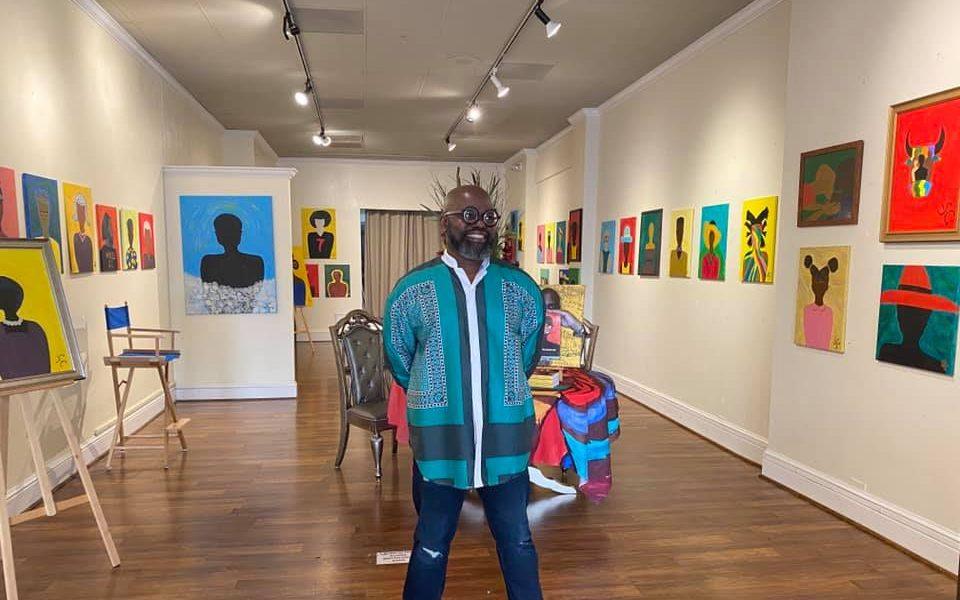Featured photo: High Point artist Freedom Clay paints faceless Black people in the hopes that others will be able to see themselves in his art. (courtesy photo)
Black and brown figures painted on canvases of various sizes line the walls of the Gallery on Main in High Point. Some figures are adults, some are children. Some have afros while others wear hats. A few are instantly recognizable as athletes or actors, like Cicely Tyson. Many are ambiguous. Despite the differences found between the subjects of the paintings, they all have one thing in common: facelessness.
According to the artist, Randy C. Rogers, who goes by Freedom Clay, the anonymity is intentional.
“I want other people to be able to see themselves and develop their own narratives based on their lived experiences and their relationship to others,” he says.
Clay has made a permanent impression on the art scene in his hometown of High Point over the last decade. His latest solo exhibition, Reimagining Freedom 2.0, went live at the Gallery on Main in May where it remained until earlier this month. The show featured more than 70 of what Clay calls “Afro-folk” art pieces with vivid colors, bold messages and themes of Black culture all dedicated to the two most influential people in his life. In 2018, he suffered the loss of his mother, Constance A. Rogers, and his grandmother, Alberta Worthy Evans, who passed away within three months of each other.
“How do I re-emerge and resurface after these great losses I’ve just experienced?” Clay asked himself.
He did so by gathering completed paintings and mixed media pieces and making new ones in response to the personal, social and political experiences of Black people.
“Little Girl True” is Clay’s interpretation of Jet magazine’s 2013 cover on missing Black children in America. The girl’s black silhouette features two twisted ponytails adorned by white barrettes. Her yellow, sleeveless dress stands out against the blood-red background.
“This powerful faceless face is the face of all Black children who are missing and for those who will never return,” Clay says.
In the painting “Sir Cotton,” a homage to enslaved Black people, the black silhouette of a man against a sky-blue background sits behind balls of cotton that rise to the middle of his arm. Some cotton balls appear opaquer than others, indicating they were created with brushstrokes of varying intensity. It’s unclear if the shadow is the front or the back of the man, but what is clear is what he’s doing.
While the subject of most of the pieces is vague, some are inspired by real people.
Clay speaks highly of his mother, who was a vivacious music lover.
“She was really the epitome of living your best life,” he says.

“Ms. Soul 2 Soul” was Constance’s multimedia piece in the exhibit, made with paint and 7-inch vinyl records, or 45s that belonged to her.
She appears in a blue gown with a green collar, the downward strokes of the paintbrush creating movement in the garment. The golden yellow background further emphasizes the positive, radiant energy Clay says his mother exuded. In her afro made of four 45s, the viewer can see Billy Paul’s Me & Mrs. Jones and Otis Redding’s The Happy Song.
In addition to being an artist, Clay is an author, releasing Nakedly Covered: A Collection of Haiku in March.
“Haiku really drew me in because it’s a very stylized poetry,” he says. “It’s very succinct in terms of being able to contextualize an idea or a statement or to get your point across in 17 syllables.”
The collection, which Clay considers one of his most personal to date, can be viewed as an open letter to Black men and boys, who are praised in the work instead of criticized.
“Black men and boys are not valued nor are we loved and appreciated in our society,” Clay says.
“The muse for this celebration was really celebrating Black men and boys.”
Although he lives in Durham now, Clay regularly returns to the Triad to host events as the founder of Artsy People of Color, a collective he started nearly 7 years ago.
“It was primarily providing an opportunity to bring Black creatives or entrepreneurs together to showcase their work in a beautiful and welcoming environment,” Clay says.
His body of work has regular items for sale at APOC’s pop-up shops, held once a month at Sabrina McGowen’s gallery in High Point.
Clay’s art aims to “examine the multi-dimensional facets and intersections of Black people in America by affirming our beauty and humanity,” he says. “My art is an amalgamation of my experiences living as a Black man in America.”
Connect with Freedom Clay on Facebook or follow him on Instagram @freedomclay. Catch him at Artsy People of Color’s next pop-up shop on 8/1 at Sabrina McGowen’s Art Gallery.
Join the First Amendment Society, a membership that goes directly to funding TCB‘s newsroom.
We believe that reporting can save the world.
The TCB First Amendment Society recognizes the vital role of a free, unfettered press with a bundling of local experiences designed to build community, and unique engagements with our newsroom that will help you understand, and shape, local journalism’s critical role in uplifting the people in our cities.
All revenue goes directly into the newsroom as reporters’ salaries and freelance commissions.


Leave a Reply